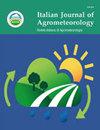亏缺灌溉和施肥对藜麦产量的影响
IF 0.8
4区 农林科学
Q2 AGRONOMY
Italian Journal of Agrometeorology-Rivista Italiana Di Agrometeorologia
Pub Date : 2022-07-19
DOI:10.36253/ijam-1136
引用次数: 2
摘要
为了研究亏缺灌溉和化肥对藜麦产量和一些生理特性的影响,2019年在两个地点(马什哈德和内沙布尔)进行了基于随机完全区组设计的分块试验。灌溉包括:I0:全灌溉,I1:出苗期不灌溉,I2:茎伸长期不灌溉;I3:开花期不灌溉。肥料处理包括对照(不施肥);根据当地做法施用化肥;施用10吨肥料;每公顷施用20吨肥料。总的来说,马什哈德的种子产量、蛋白质和籽油的百分比高于内沙布尔。I2处理对叶片相对含水量的负面影响最小。与对照相比,施用化肥、10吨和20吨动物粪便分别使种子蛋白质含量增加1.43、1.66和2.37。在Mashhad的处理I2中获得最高百分比的籽油(5.91%),而在Neishabour的处理I4中获得最低百分比的豆油(4.18%)。在内沙布尔观察到I1处理导致的最低种子产量,而在马什哈德观察到的最高种子产量与20吨粪肥的I0处理有关。结果表明,灌溉方式、肥料来源和施肥地点可以改变藜麦的产量和耐水胁迫潜力。本文章由计算机程序翻译,如有差异,请以英文原文为准。
The effect of deficit irrigation and fertilizer on quantitative and qualitative yield of quinoa (Chenopodium quinoa)
In order to investigate the effect of deficit irrigation and chemical fertilizers on yield and some physiological traits of quinoa an experiment was conducted in 2019 as split plot based on a randomized complete block design in two locations (Mashhad and Neishabour). Irrigation included, I0: full irrigation, I1: no irrigation at emergence stage, I2: no irrigation at stem elongation stage, I3: no irrigation at flowering stage, I4: no irrigation at seed setting stage. Fertilizer treatments included control (no fertilizer application); chemical fertilizer application according to local practices; manure application of 10 tons; and manure application of 20 tons per hectare. In general, seed yield, percentage of protein and seed oil in Mashhad was higher than in Neishabour. I2 treatment had the least negative effect on relative leaf water content. Application of chemical fertilizers, 10 tons and 20 tons of animal manure increased the percent of seed protein by 1.43, 1.66 and 2.37 compared to the control, respectively. The highest percentage of seed oil (5.91%) was obtained for treatment I2 in Mashhad and the lowest percentage of seed oil (4.18%) was obtained for treatment I4 in Neishabour. The lowest seed yield due to I1 treatment was observed in Neishabour and the highest seed yield was related to I0 treatment with 20 tons of manure and was observed in Mashhad. The results showed that the yield and water stress tolerance potential of quinoa can be modified by irrigation, fertilizer source and location.
求助全文
通过发布文献求助,成功后即可免费获取论文全文。
去求助
来源期刊

Italian Journal of Agrometeorology-Rivista Italiana Di Agrometeorologia
AGRONOMY-ENVIRONMENTAL SCIENCES
CiteScore
2.10
自引率
8.30%
发文量
6
期刊介绍:
Among the areas of specific interest of the journal there are: ecophysiology; phenology; plant growth, quality and quantity of production; plant pathology; entomology; welfare conditions of livestocks; soil physics and hydrology; micrometeorology; modeling, simulation and forecasting; remote sensing; territorial planning; geographical information systems and spatialization techniques; instrumentation to measure physical and biological quantities; data validation techniques, agroclimatology; agriculture scientific dissemination; support services for farmers.
 求助内容:
求助内容: 应助结果提醒方式:
应助结果提醒方式:


